DJI Mavic Mini Review
DJI Mavic Mini Review
How does DJI’s most affordable drone stack up?
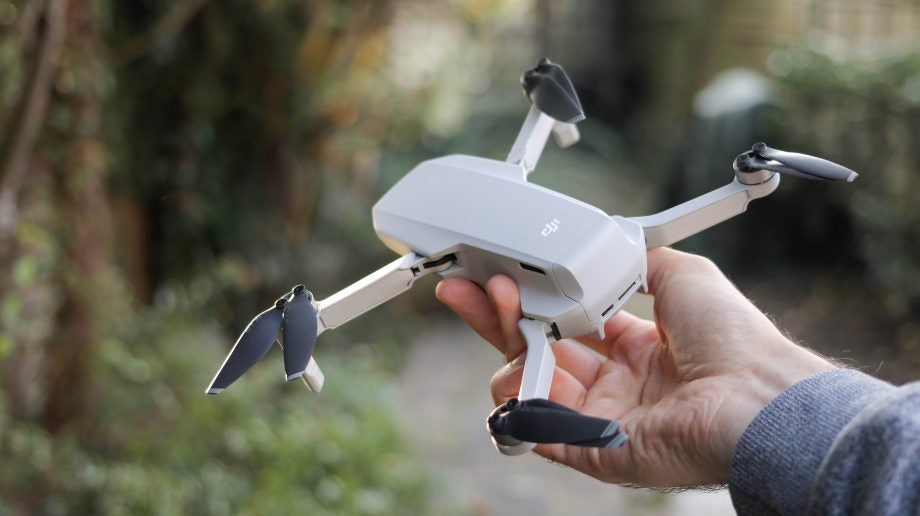
Verdict
For what it is – a 249g drone that captures 2.7k video and fits in the palm of your hand, nothing comes close to the Mavic Mini. Its footage is stable, battery life exceptional and the drone is portable too. We would have loved 4K capture, object tracking and more control over the look of our footage, but irrespective, the Mavic Mini is an excellent drone in a league of its own thanks to its weight and the fact it won’t need to be registered with your local authorities.
Pros
- Most affordable DJI drone
- Great 3-axis stabilisation
- No need to register with authorities
Cons
- No 180-degree camera tilt
- No object tracking
- No 4K capture
Key Specifications
- Review Price: £369
- Fly More kit costs £459
- Compact, foldable drone
- 2.7K 30fps video
- 1080p 60fps
- 12-megapixel still images
- QuickShot automated flight modes
- 30-minutes flight time
The Mavic Mini is DJI’s most affordable drone, and its lightest too at 249g. That’s important because drones over 250g need to be registered with national authorities in the US and UK, which means the spritely Mavic Mini manoeuvres just under that bar.
Smaller than the Mavic Air, which is substantially smaller than the Mavic 2 range, the Mavic Mini’s offering is less premium, with 2.7K maximum resolution video recording at 30fps vs the 4K capture of the Mavic Air, though the incredibly handy automated flying modes, ‘QuickShots’ have made a return in a slightly stripped back guise.
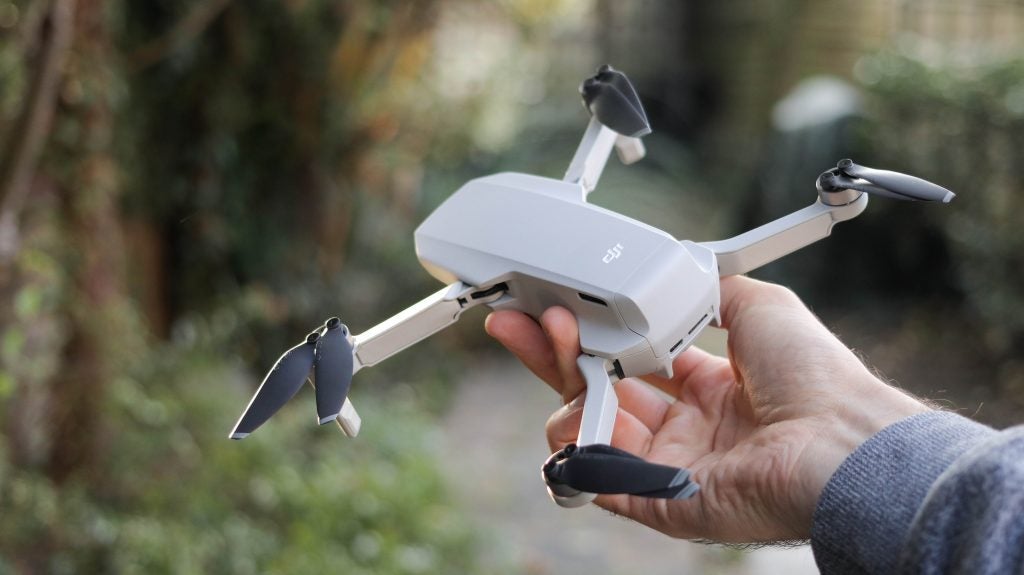
At 249g, the Manic Mini is exactly 1g under the weight which requires drone registration in the UK and US
The Mini is available in two configurations – the first is the base pack which features the drone and essentials, a battery and controller and costs £369. Given the choice though, we’d opt for the pricier pack, DJI’s £459 Fly More bundle, which includes a carry case, three spare batteries, a triple battery charger and flight guards, protecting the Mini from damage. Not only does the extra hour of flight time the additional batteries deliver justify this cost, but the guard is a must-have if this is your first drone, especially if you’re flying the Mini indoors.
This sets out a clear ‘flight path’ for DJI’s drone portfolio. The Mavic Mini is the new entry-level option with 2.7K recording, then the Mavic Air takes the resolution up to 4K and includes object tracking at £699. Next, the Mavic 2 Pro and Pro Zoom are, as their names suggest, drones for serious enthusiasts and professionals.
Related: Best drones 2019
DJI Mavic Mini – Design
Just like the leaks have been letting on in the week preceding its announcement, the Mini is so small, it comfortably fits in the palm of a hand when its arms are neatly tucked in. Just like the DJI Osmo Action and Osmo Mobile 3, its colour scheme is two-tone grey, and it looks stealthy and sleek – exactly what we’d expect from a Mavic drone.
Unwrap it, pivoting its front arms backwards and its back arms forward and it transforms into a familiar quad-copter. At the front is the camera, which is stabilised on a three-axis gimbal – looking virtually identical to the camera on the DJI Osmo Pocket.
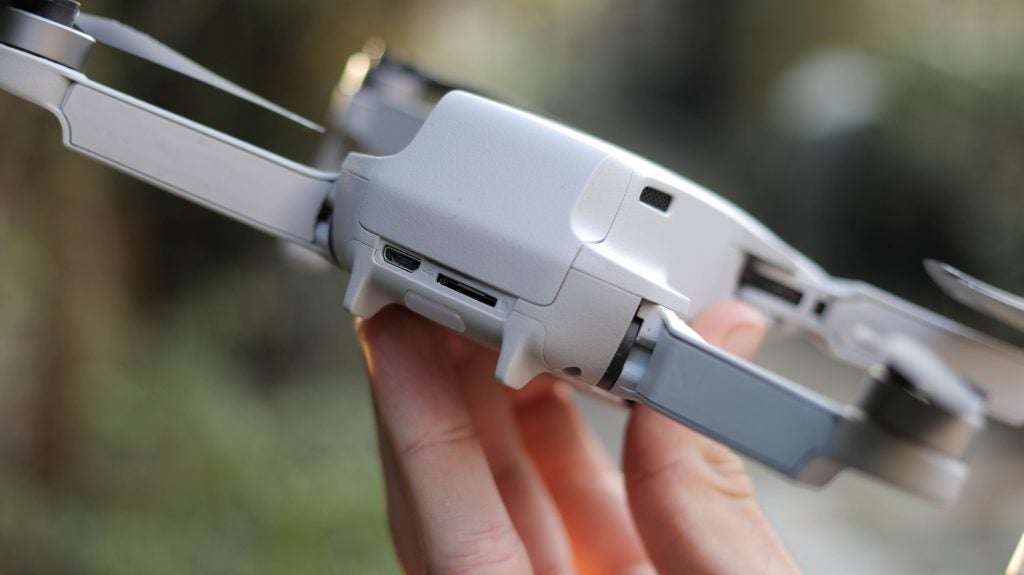
There’s an SD card slow and micro USB port, but no USB-C
The back is home to a microSD card slot and micro USB port – both exposed and above these is a door for the battery. We would have loved to have seen a USB-C port here, but that’s probably our biggest gripe with the mini from a connections point of view.
The drone’s undercarriage features a fair few lights. For starters, there are four small LEDs, which act as battery indicators and alert you when you’ve switched it on and off. There’s also a coloured orange, red or green light so you can keep tabs of your drone in the air, with each colour signifying a different status, and there are object avoidance sensors too. These are only on the base to help with landing, not around the front, back or sides as found on more premium drones.
Related: DJI Robomaster S1 is an educational tank drone that’s every bit as cool as it sounds
DJI Mavic Mini – Features and flight
Expanding on that last point, unlike the Mavic Air, the Mini doesn’t feature the combined seven cameras and IR sensors onboard the Mavic Air to make sure it steers clear of objects, making the Fly More pack’s flight guards even more desirable.
We flew the Mavic Mini in parks in Ealing, which is one of the few London boroughs which permits flight provided you’re sticking to the laws of the land, and getting it up and running was simple. We slotted the battery in the Mini, installed the app on our phone, unfurled the controller, connected the controller to the phone, powered it and the Mini on and we were good to go.
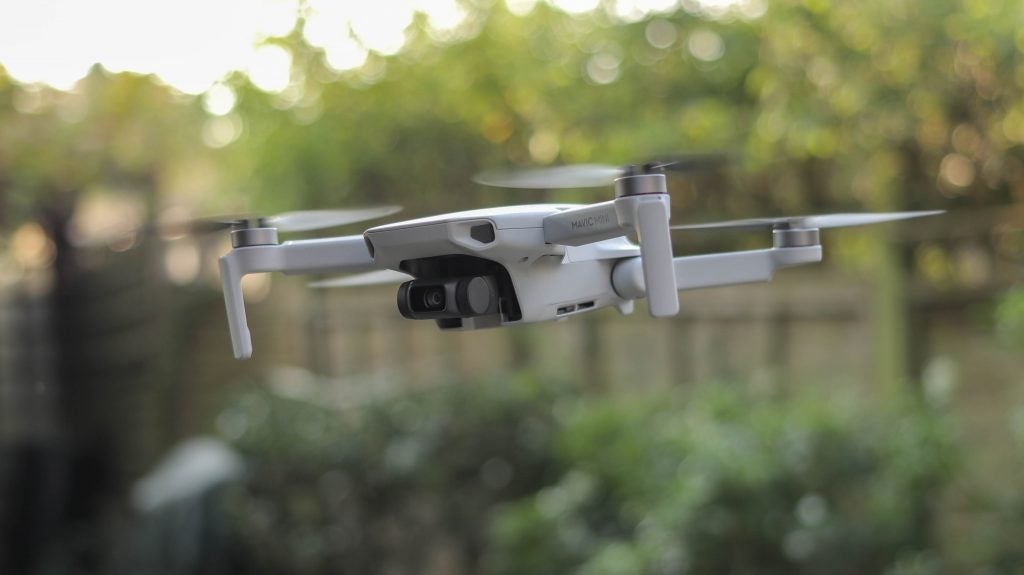
DJI has launched a new app to control its Mavic Mini called Go Lite. The version we used was a Chinese pre-release build, but it was still easy enough to navigate through, even with the language barrier. Fire it up and there are a series of quick start guides to make sure you have safety on the brain before you get off the ground.
When compared to other DJI drone controller apps, and the Parrot ANAFI’s, Go Lite is less fully featured. There’s no object tracking, you can’t control the video image profiles with control over saturation, contrast or swap looks, which you can do on the Osmo Action, for example, to add a flatter, cinema-style aesthetic to your scene.
That said, there is still QuickShot, which predefines a flight path so the Mavic Mini captures a range of clips that look like they are being controlled by a drone master. These circle around a subject, or soar up at a 45-degree angle for a perspective building vertical long pan, and look sensational.
The Mavic Mini package ships with a controller, whichever pack you buy, unlike the base Mavic air pack – only the Fly More Mavic Air bundle includes a controller. That’s because you can’t fly the mini with just your phone. The controller itself is a compact device that’s like a sleeping beetle. Unfurl its shell to wake it up, flick up its antennae, and extending its wings to hold your phone. There are also two joysticks that can be screwed on for ergonomic flying – it’s really easy to pick up and get to grips with.
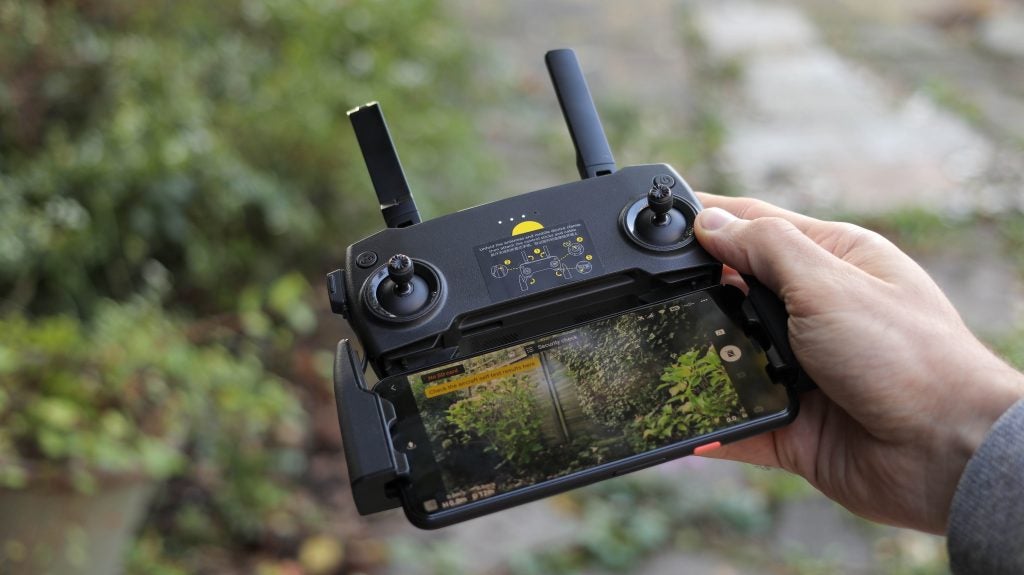
The drone ships with a controller which connects to your phone
Going a step further, the controller also charges your phone with its 2600mAh battery. The Mavic Mini ships with all the cables you’ll need – Lightning, micro USB and USB-C, and using the wireless link of the controller rather than that of your phone, DJI promises solid connectivity.
In our experience, how great the connection is will depend on where you’re using the drone, with it working well in excess of 70m in less congested areas, but dropping out at about 40m in an environment teeming with WiFi connections. All these numbers should be taken as loose references though, given the fact we’re yet to use the Mavic Mini with the final version of the app.
We had no issues using the controller across multiple phones, having tested it with an iPhone 11 Pro Max, a Pixel 4 and a Realme X2 Pro. As for buttons, there’s a left and right joystick for movement across the X and Y axis, as well as an L and R tricker for quick-fire photo and video capture. In addition, there’s a jog wheel on the back which controls the vertical angle of the camera.
The drone app features three capture modes: Position – the default mode, Sports – which gets very fast, and CineSmooth, which slows down movements for those cinematic pans.
We found ourselves staying in CineSmooth for the most part, given the lack of 60fps 2.7K capture. The slower the footage, the more we could do with it, and it’s much better to speed up drone footage in the editing phase (provided there are no tell-tale speed markers like cars).
Related: Drone racing just got a whole lot better, thanks to DJI’s new Digital FPV Ecosystem
DJI Mavic Mini – Video and image quality
The Mavic Mini is something of a Mavic Air / Osmo Pocket love child. It naturally borrows many design cues from the Air, but on the front is a three-axis gimbal with a 1/2.3” sensor. Combined with 12MP resolution and up to 2.7K video capture – that’s all Osmo Pocket right there. We even found ourselves walking around with the Mavic Mini, capturing video and using it as an impromptu stabilised camera to great effect.
Unlike the pocket, there are no advanced night shooting tools though when it comes to photography, but there is a manual stills photography option, enabling an ISO of up to 3200 and a max shutter duration of four seconds.
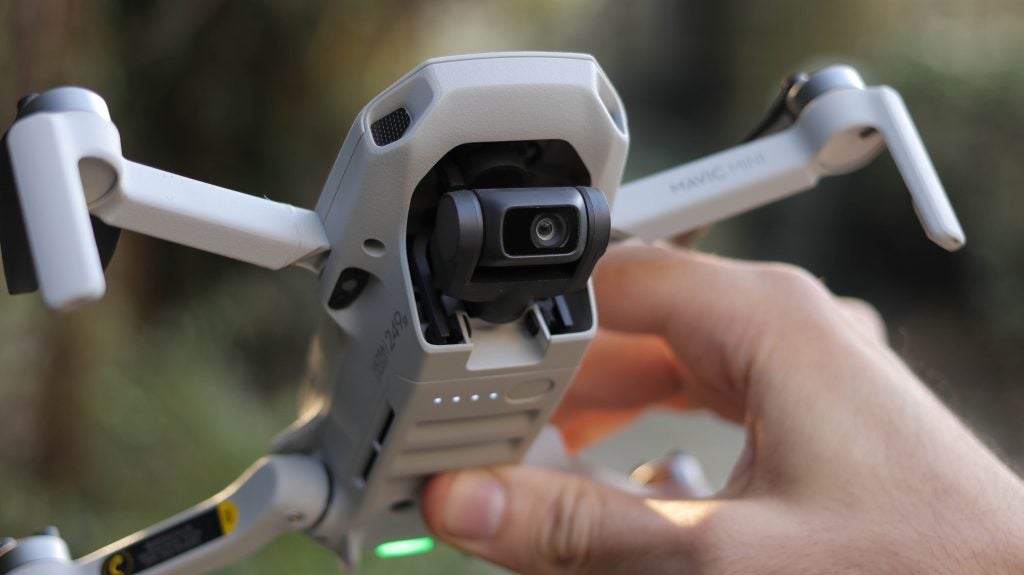
Image quality is comparable though, with well-lit conditions producing punch, vibrant footage with respectable detail. Filmmakers may not love the lack of control over the look of footage captured, but if you can match the colour profiles, the 2.7K video can be slotted into a 4K project without the drop in clarity raising any eyebrows.
Night shooting, however, isn’t great, which can be said of most drones, with noise creeping in quickly – hardly surprising with such a small sensor.
That said, stabilisation is nothing short of sensational on the Mavic Air, even in windy conditions. The app alerted us when the drone was experiencing turbulence, but after studying the footage captured, no juddering made it through to the final recording.
DJI Mavic Mini – Battery Life
With a quoted flight time of 30-minutes, weather conditions pending, the Mavic Mini is one of the most impressive drones around from a battery point of view, and our real-world experiences weren’t too far off this, averaging between 25 and 30 minutes.
The Fly More pack really is a no-brainer if you think you’ll be out and about for more than half an hour at a time, and DJI has also enabled charging via the drone’s micro USB port – something the Air didn’t support. In turn, while we wish it was a USB-C port, we’re thankful for this addition.
Another point to add, the three 2400mAh batteries in the Fly More bundle slot into a charger that can power can also be used as a power bank, so can charge a phone or the Mavic Mini’s controller or even your phone.
Should you buy the DJI Mavic Mini?
If you are getting into drone videography and want a guaranteed quality solution, the Mavic Mini is a great option. Yes, you can get 4K drones for less, but the ones currently on the market won’t always deliver the quality we’ve come to expect from DJI. Additionally, none will weigh less than 250g, so will need to be registered with the CAA in the UK, or FAA in the US.
The Mini’s also a solid addition to a filmmaker’s drone arsenal, though, with limited control over the look of the footage captured at the time this review is being written and no 4K capture, professionals may well want to stump up extra for a more fully-featured alternative.
Verdict
For what it is – a 249g drone that captures 2.7k video and fits in the palm of your hand, nothing comes close to the Mavic Mini. Its footage is stable, battery life exceptional and the drone is portable too. We would have loved 4K capture, object tracking and more control over the look of our footage, but irrespective, the Mavic Mini is an excellent drone in a league of its own thanks to its weight and the fact it won’t need to be registered with your local authorities.


